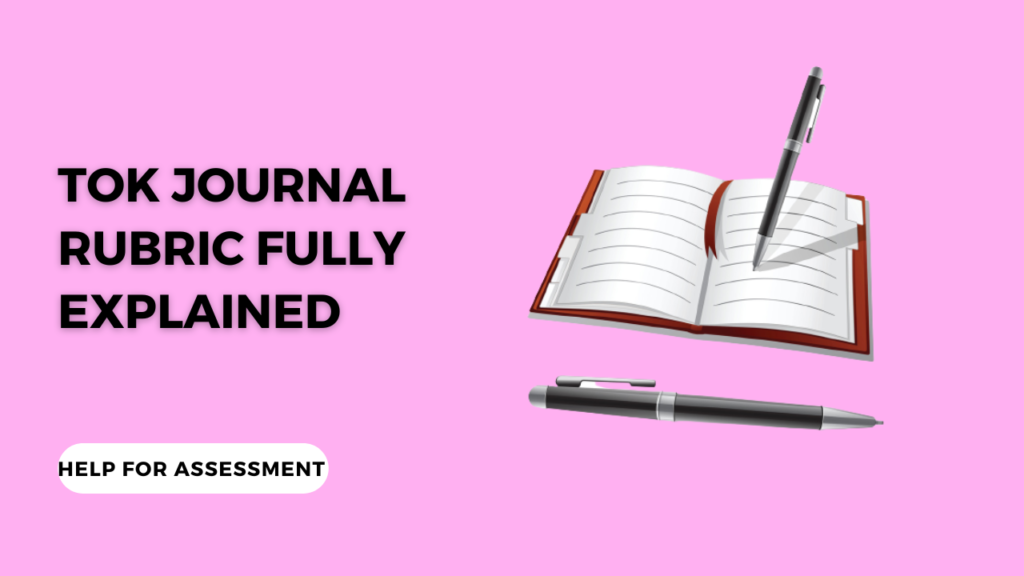We understand that writing a ToK journal can be somewhat challenging. However, it shouldn’t be the case once you learn and understand the rubric.
Our goal with this guide is simple:
We want to help you to understand what makes a good journal and what doesn’t according to the assessment criteria.
By the time you finish going through this post, you’ll have a clear picture on what to avoid and how to make your journal stand out.
Let’s get started.
Key Takeaways
- IB marks the ToK journal out of 7 points, which reflects in your class’ total grades.
- Focus on scoring an excellent, which is between 6 and 7 points, but there’s no shame in getting a satisfactory grade for the assignment.
- The last mistake you want to make is to be off topic. You’ll get a 1 in this case to signify that you never bothered to look at the prompt.
ToK Journal Rubric Explained
The following is an explanation of the TOK Journal rubric:
Irrelevant (1 Mark)
TOK teachers award 1 point for vague journal entries. If an IB student gets a 1, it means they didn’t take the time to engage in the assignment, leave alone pay attention to the most important aspects of the assignment.
On understanding and knowledge, one point shows that the student failed to respond to the prompt, not to mention that they are off topic.
The student may choose to redo the assignment, but they will have to get served with a detention.
Elementary (2 Marks)
On understanding knowledge questions, the journal entry doesn’t have an instance of relevance. The student has attempted to put some words down to paper, but the journal is 100% irrelevant to the stimulus material or prompt.
They may have included relevant points in their work, but these are merely descriptive.
The quality of analysis of knowledge question shows that the student may have offered arguments in their work. However, they fail to provide support for these arguments. The result is a paltry, abysmal, and formless journal entry with a ton of incoherent information.
Basic (3 Marks)
On understanding the knowledge question, basic ToK journals feature knowledge questions somewhat connected to the prompt or stimuli material. However, the journal lacks relevant description. More often than not, these journals contain superficial or limited link to ways of knowing or areas of knowledge.
As far as the analysis of quality of the knowledge question is concerned, the argument presented by the student are unclear. Also, the student fails to prove effective examples to support their arguments.
On possible characteristics, the journal entries that earn 3 points are rudimentary, underdeveloped, simple, confusing, derivative, and possibly disjointed.
Satisfactory (4 Marks)
On understanding of the knowledge question, scoring a 4 means the student has focused on a question connected to the stimulus material or prompt. Also, they have presented some clear development and a link to areas of knowledge or ways of knowing.
For quality of the analysis of the knowledge question, the student has provided clear arguments. The student has even attempted, in some instances, to support their arguments with clear examples. However, they may or may not have included counterclaims in their assignment.
Overall, the work is typical and mainstream. And while it’s ordinary in some cases, at least it demonstrate the work of a student who is ready to produce adequate work.
Very Good (5 Marks)
On the concept of understanding knowledge questions, the student has scored a 5 because their TOK journal entry has a focus on a knowledge question connected to the selected prompt.
Also, they’ve developed an acknowledgement of different perspective linked to the areas of knowledge or ways of knowing.
As far as the quality of analysis of knowledge questions is concerned, the student presents clear arguments supported by real-life examples. They also address counterclaims to make their journal entries credible, relevant and thoughtful.
Excellent (6 to 7 Marks)
The student demonstrates that they have a clear understand of the knowledge question. They sustain a full focus on the question connected to the prompt and develop a clear investigation of the perspectives linked to the areas of knowledge or ways of knowing.
On quality of analysis of knowledge questions, the student has provided clear arguments as well as “real-life examples” to support their arguments. In addition to effectively evaluating these examples, the student explores their counterclaims and draw their implications.
Students who score 6 to 7 have the best journal entries. More often than not, these journals are personalized, lucid, insightful, and quite compelling.
Need help to complete and ace your essay? Order our writing service.
Get all academic paper features for $65.77 FREE
Conclusion
We hope that this guide has helped you to understand what makes a good ToK journal rubric and what doesn’t.
If you still have a difficult time with the assignment and you would like some writing help, feel free to get in touch with us today and we’ll help point you in the right direction.


